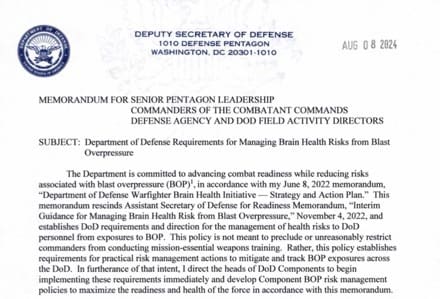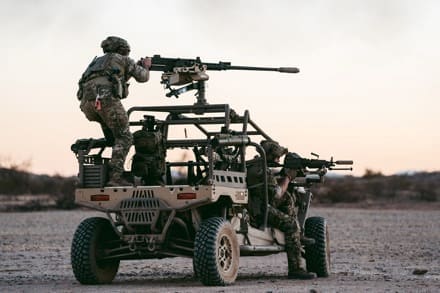Just over a year ago, the Deputy Secretary of Defense issued a memorandum updating the requirements for managing brain health risks from overlooked sources of overpressure such as training with common weapon systems. It established DoD requirements and direction for the management of health risks to DoD personnel from exposures to Blast Over Pressure (BOP) and offers information on risks, ways to mitigate them, PPE suggestions, and who is likely at risk. The linked guide helps with specific techniques.

We’ve long known about the dangers of BOP resulting from Improvised Explosives Devices and other high order explosive events. The sudden onset of a pressure wave and associated above normal atmospheric pressure has led to physical injuries such as Traumatic Brain Injuries as well as hearing and vision loss. The damage to our troops is widespread. In 2020, there were 1.3 million Veterans receiving benefits for hearing loss while studies show that close to half-a-million Veterans have sustained TBIs.
What we’ve learned is that our troops have also been exposed to BOP in training for combat, just like they are when bullets are flying in both directions.
In particular, the policy focuses on exposures to BOP above 4 pounds per square inch (psi) which studies have shown can result in adverse effects on brain health and cognitive performance ( e.g., headache, decreased reaction time, attention difficulty, memory loss) resulting from acute (e.g., single or short-term) and chronic (e.g., repetitive or continuous) exposure to BOP.
In addition to damaging the personnel that wield those weapons, they can also affect any platforms they are mounted to such as light vehicles and aircraft as well as sensors and other weapons mounted to those platforms. This could include guided munitions, proximity fuzed warheads, and ISR gear. Now, we are facing a drone threat and have just begun fielding sensors and fire direction systems for the CUAS fight. Damaged equipment results in increased costs and down time for maintenance and in some cases, it can result in fatalities.
The policy memo does not preclude or unreasonably restrict commanders from conducting mission-essential weapons training. Rather, it establishes requirements for practical risk management actions to mitigate and track BOP exposures across the military.
My main issue with the memo itself is that it named specific careerfields as those likely to be exposed to BOP and overlooks some combat related specialties (enlisted AFSW) as well as those enablers assigned to close combat forces who often man crew served weapons in both training and defense of their formations. More appropriate would have been a more broad approach which included personnel assigned to certain types of units.
This matters for two reasons. First, some leaders may overlook personnel during risk management and second, the Veterans Administration will assuredly use this memo to deny services and compensation to those not specifically listed in the memo.

Regardless of who the memo includes, the reality is that anyone who uses or is in close proximity to these weapon systems during firing is exposed to the same overpressure forces. Fortunately, the military is beginning to take measures to limit unnecessary exposure and mitigate the effects where possible. Over the next couple of weeks we are going to examine how industry is working with government to create blast reduction standards and apply them to weapon systems in the form of Unconventional Personal Protective Equipment such as suppressors.
Both comments and pings are currently closed.
Read the full article here



